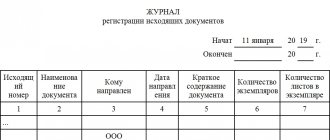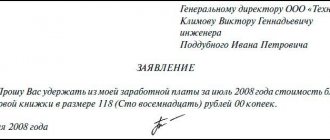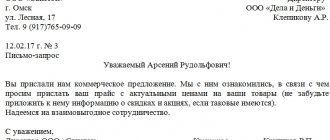Legislative Perspective
It should be noted that there is no single approved procedure that would regulate the procedure for filing documents.
There are a number of departmental instructions regulating the work with documents in a particular industry. Thus, the procedure for filing documents in archival institutions is regulated by Methodological recommendations for the development of instructions for office work in federal executive authorities, approved by Order of the Federal Archive of December 23, 2009 N 76. In the financial sector - by the Instruction of the Central Bank of Russia, in the Tax Ministry - Methodological explanations on the procedure for filling out individual forms documents that are approved by the Order of the Ministry of Taxes and Duties dated April 18, 2003, there is also the Order of the Ministry of Culture of Russia No. 536 of 2005, which approves the standard instructions for office work as well as GOST R 51141.
All of them regulate, in general, a uniform procedure for stitching materials. Using it, you will avoid a lot of delays and save your time.
In some cases, for example, when a private entrepreneur submits documents for state registration, incorrectly filed documents will be returned to you to correct the shortcomings.
Step-by-step guide to flashing the firmware
As a rule, the organization and binding of documents is carried out by an employee who is charged with this by order of the boss or enshrined in the official instructions.
When flashing documents, the following sequence is observed:
- Documents are folded according to dates or numbers, in the correct order and with the correct side.
- All paper clips and staples on the documents are removed so as not to interfere.
- Now you need to evenly fold the stack of documents; if there are only a few of them, this is not difficult. In case of large volume, a special device is used.
- The next step is making holes. After stapling the document, it should be readable. To do this, holes are made at a distance of up to 1.5 cm from the edge. There should be at least 3 of them, if the documents are important - 5.
First, mark the points at the puncture sites. The central hole should be in the middle of the sheet, the other two at a distance of 3 cm from it up and down, if there are five of them, then the next ones are also at a distance of 3 cm, respectively.
- If there are up to 5 sheets, the hole is made with a needle or hole punch; in thicker cases, with an awl. In documents that are transferred to the archival storage, up to 250 sheets are allowed; holes are drilled in them with an electric drill or a special device is used.
- Now you need to thread thread or twine into the holes. For strength, they are stitched twice, so that the ends of the thread are on the back side. The length of the ends is 6 - 7 cm, they are tied in a knot, very tightly, as tightly as possible to the outer leaf.
- A paper sticker (certifying sheet) measuring 4x8 cm is glued on top of the knot and thread, but so that the ends of the thread are visible and the knot on it is clearly visible. The entire leaf is filled with glue and carefully glued; this is necessary to preserve the case and the materials contained in it and to prove their authenticity. You can prepare a printed version of the leaf by typing the text in Word and then cutting out a strip of the appropriate size. The text is:
The file is laced, numbered and sealed with ___( _______) sheets
Signature _________________ (position, surname and initials)
- Now you need to number the documents. The place for numbers is the upper right corner, numbered with a black pencil. Writing in ink is not permitted. Numbers should not cover the text.
Numbering is strictly regulated:
- Only sheets and in no case pages are numbered;
- the inventory in the file is not subject to numbering;
- letters with envelopes are numbered as follows: first the envelopes are numbered, then the remaining sheets;
- materials that are already numbered are still numbered again;
- larger sheets are folded and numbered with one number;
- documents with accompanying materials firmly attached (travel forms, invoices, photos) are designated by one number. This is done like this: on the reverse side of the main sheet, an inventory of the attached documents is written by hand, only the main document is numbered, the number of attached materials is indicated in a note to the inventory, or in the certification sheet it is noted: “on sheet No. so many sheets are included according to the inventory on turnover";
- on documents in the form of photographs, drawings, drawings, numbers are affixed on the reverse side;
- The digits of the license plates are entered in Arabic numeral format and in ascending order;
- in multi-volume cases, the pages of each volume are numbered separately.
- when the glue dries, the number of sheets is written on the witness in Arabic numerals and in words in parentheses, it is signed by the person responsible for drawing up the case, and the legal documents are signed by the head and a seal is affixed.
Please note that the signature and seal must be placed so that part of it is located on the certification sheet, and part directly on the document being certified. According to the established procedure, this is considered a guarantee of authenticity and integrity.
All bound sets of documents are accompanied by an inventory sheet, which indicates:
- Name of the organization;
- Title of the document;
- Date of preparation;
- table of contents (annotation of the purpose of preparation) containing a short list of included materials4
- number of sheets;
- shelf life;
and the compiler (his position, surname) and his signature are indicated (required).
- According to the rules, there is no number on the inventory.
- A case prepared for submission to the archive is supplied with a cover of 229×324 cm (required); when non-standard materials are included, the cover corresponds to the actual parameters.
Numbering of sheets when binding documents – Lawyer Vladislav Anokhin
Unintentional dissolution of papers, forgery, refusal to check or store, return of applications unexamined - these are just some of the consequences of improperly systematized internal documentation. To avoid fines and other unwanted incidents, you should take a responsible approach to organizing the firmware.
Often they require hemming in more than 3 holes. The question arises, how to hem things with 4-hole threads. The sequence of actions if you need to figure out how to sew things with 4 holes is as follows:
- Make holes with a needle;
- Insert the needle from the wrong side through hole number two;
- Insert the threads into the first hole on the right;
- Afterwards the needle is sent into two holes on the right;
- The needle is then sent into the third hole on the right;
- After which there is a transition to the left protocol;
- Move to the third hole;
- It is necessary to make a conclusion on the reverse side and secure it with a knot.
Covers for documentation come in three types:
- Standard – the usual cover that is most often found. Cover size 229x324 mm, accommodates standard sheets (mostly A4).
- Non-standard – used if the document format is of an unusual size.
- For long-term storage - these covers are made of durable cardboard for longer storage. They must be dense and wear-resistant.
Responsibility
Some documents are of increased importance and therefore require closer attention to storage and execution. Firmware and numbering of documentation is not a whim at all, but protection from making illegal changes by tearing out/adding pages and other unauthorized actions.
Is it necessary to flash magazines in a private office? The answer is yes. It doesn’t matter at all what form of ownership the organization has, an audit can easily come to an ordinary individual entrepreneur, because the law is the same for everyone.
When hiring a secretary or clerk, it is better to immediately clarify whether the candidate knows how to bind books and how he does it? If difficulties arise in answering this question, keep in mind: this applicant will not become a reliable partner, because the skill of firmware is no less important than the ability to write letters correctly or quickly type texts on a computer using the “blind ten-finger method.” And the good news is that this knowledge can be easily obtained once you have dealt with this issue.
In some structures, for example the security forces, the internal audit service always conducts an audit with particular passion, and first of all looks at whether the logs are properly formatted; they even check the lacing of the personnel notes!
All cash registers must be stitched first; everything related to finance is always the focus of control services. You should flash a book of complaints, a book of orders, and journals for notes on incoming/outgoing correspondence and other things.
Some journals are kept at enterprises for years; in these cases, it happens that the firmware thread helps the book simply not fall apart into its component parts due to old age.
Filling out the title page
We write the name of the object correctly - with permission for construction or reconstruction. If they are not there (for example, during a major overhaul), we write the name of the object from the contract. Next, we collect copies of orders appointing responsible persons of the Developer, Customer, General Contractor, Subcontractor. We ask each of them to sign in the “signature” column. At the same time, we are collecting the details of all these organizations (you can just ask the responsible persons). Whether you have a printed magazine or a homemade one, you need to stitch it, number the sheets and seal it with the Customer’s seal. The number of pages is also indicated on the title page.
Useful tips
- Even the most ordinary student notebook can become a journal.
- Having sifted through information on how to flash a magazine, you may not always come across the following useful advice. Watch the tension; the stitching must be done loosely enough, otherwise the lace/thread will cut into the holes and tear the pages, or the book will not be able to be opened completely. A tightly bound journal does not allow for writing in the center of the spread.
- You can also find the required standard form on the Internet, print it out, punch it with a hole punch, sew it, and stick on a “control.”
- It is advisable to attach the control sheet with a glue stick: PVA takes a long time to dry, and moisture often blurs the signature and seal put by the manager in a hurry.
- There are situations when it is still necessary to make some changes to the log. For example, due to an unfortunate oversight or irresponsibility of an official, incorrect data was entered, or there is no registration information at all, in which case it is sometimes necessary to rewrite the log completely.
Some results
Let us repeat the basic rules stated above:
We hope that after reading the article you have no questions about how to flash the logbook and similar documents.
Let us repeat the basic rules stated above:
- Before work, carefully study the instructions on how to flash the magazine.
- Decide on a “piercing” tool.
- Do not pierce the cover (only the sheets themselves).
- Do not make holes far from the cover - the magazine will be inconvenient to open.
- The thread must be strong.
- Do not miscalculate the length of the thread, so as not to redo everything again.
- Number the magazine.
- Paste a control sheet, which will indicate the number of pages to be stitched and the date of stitching.
- Seal it.
We hope that after reading the article you have no questions about how to flash the logbook and similar documents.
How to hem documents correctly and with what thread.
Thanks to the correct firmware, documents are easier to organize. Many documents are transferred to the archive. It is more convenient to store bound multi-sheet documents and provide documents to inspection authorities. The papers remain completely intact, eliminating the possibility of substitution, forgery or loss.
- The issue of correct document firmware is of concern not only to employees of government agencies, but also to representatives of small businesses.
- If the firmware is not installed correctly, the registration process may take an indefinite period of time. Correct firmware is a guarantee of maximum documentation protection.
How to perform firmware according to existing requirements? How to do everything the first time if there is no clear set of rules for filing office papers? The material in this article is devoted to various methods of flashing documentation.
Registration of the charter
Many entrepreneurs are often faced with the need to staple documents. Before you start installing the firmware, you need to prepare all the papers. Documents are usually stitched in three holes. Many people don’t know how this is done, but there are no difficulties here. After flashing, you will need to number the sheets. Traditionally, heavier threads are used for stitching. Documents can be stitched twice and then there will be no doubt about their strength. Certification of documents is another important point. This phenomenon becomes relevant if the documents are stitched for the tax authority. There is a need to confirm who stamped the documents and when this happened. If an entrepreneur is familiar with such a procedure as document flashing, then he will be able to avoid many problems and keep his nerves in order.
Rules for stitching GOST documents
- If you need to staple office papers on several sheets, then first of all you need to familiarize yourself with the regulations. Of course, the first thing that comes to mind is glue or a stapler. Multi-page documents cannot be pasted. But how do you sew them together? After all, incorrect firmware can result, at a minimum, in a refusal to register an authority requiring you to provide a package of documents.
- What to do if there is no set of rules and samples, and it is impossible to stitch papers as it turns out, and not as it should be. Despite the fact that there are no clear instructions regarding the binding of documentation, it is necessary to focus on the specific requirements of the authority that requests information in the form of a bound package of documents.
- It will also be useful to familiarize yourself with general recommendations for flashing documents that consist of more than one sheet. They are collected in a brochure or guidelines for 2009. There is also a brochure for 2004. It is more suitable for registering LLC documentation.
Rules for stitching GOST documents
- The methods of stitching sheets described in the brochures refer to documentation that must be stored for more than 10 years.
- The stitching of multi-page documents is performed using a regular needle and thick thread. But how to learn how to properly flash enterprise documentation? After all, this skill will come in handy more than once throughout your bureaucratic or entrepreneurial career.
What documents are stitched?
- Personnel documentation based on the results of the current year
- Accounting documentation
- Clerk's incoming and outgoing documentation
- Documents for the tax office
- documents for submitting reports to the Pension Fund of Russia
- documents to various departments of the bank
- tender documents
- copies of statutory documents
- documents for concluding particularly important agreements
- profit books
- notarized copies and translations
- when preparing documentation for archiving
What documents are filed?
- It is customary to stitch a package of documents with a needle and thread. This allows you to maintain their integrity: in this type of paper it will be difficult to replace, which is very important today.
- Sometimes it is allowed to use a stapler to staple documents. The ideal option is to use special equipment.
- Accountants of many organizations are switching to working with accounting programs. They do not need to be duplicated on paper. There is online accounting for this. Electronic documents signed with a digital signature have the same legal significance as paper documents (for example, invoices).
- But, despite the ease of working with documentation in digital format, we will have to deal with the usual paper documentation for a long time, and the preparation of some documents is already required.
Office documentation has different meanings. Documents differ in the thickness of the file and the shape of the sheets. That is why there are several ways to flash documentation.
Stitching machine
What external differences might there be between the stitched objects:
- a document that consists of 2 or more A4 sheets
- accounting documents, including cash documents, consisting of varying numbers of documents, are stored in cardboard boxes
What thread should I use to stitch documents?
- If you don’t take the filing of documentation seriously, then the papers prepared for delivery may simply be returned to you with a requirement to completely redo the firmware. Therefore, it is advisable to familiarize yourself with the rules of stitching and the basic requirements before serious errors are made in the firmware of documents.
- Another option to solve the problem is to turn to professionals. If you don’t have time to study the issue of firmware documentation, then you can entrust this to the specialists of a printing company. It will take 10-30 minutes to stitch documents with a plastic or metal spring with a cover.
- But there is a certain risk in entrusting your documents to a third party: the papers may contain trade secrets.
- Therefore, you should carefully read the instructions once on how to stitch documentation of various formats using ordinary threads or a stapler.
What thread should I use to stitch documents?
- The documentation is sewn together with bank twine, thin Mylar tape or stitching threads. But if there are no such threads, then ordinary harsh threads will do.
- 2-3 sheets are sewn together with regular thread. It needs to be folded in half for strength. The stitching process begins with holes being made in the sheets. The stitching is done from the back side of the sheets assembled together.
- The needle is inserted first into the middle hole. It is better to use dual firmware. When the stitching is completed, the needle and thread are inserted into the central hole and brought out to the back of the assembled documents. The remaining end of the thread must be tied in a knot.
The documentation is sewn together with bank twine, thin lavsan tape or stitching threads
How to stitch documentation with thread
Preparing accessories:
- needles and thread of suitable thickness
- documents that need to be flashed
- an awl or other tool for making holes in paper
- organization seal
- stationery glue
We stitch the document in 3 stages:
- We are preparing papers for stitching. To do this, you need to arrange them into groups
- Checking whether the numbering is correct
- Stitching
- We draw up an accompanying inscription.
- We are preparing an internal inventory.
- We certify the finished work
Preparing the document Stitching Tie the ends of the thread with a knot Seal
For a bound package of documents, the following is allowed:
- skip the stage of document systematization
- distribute documents without numbering
- It is possible to submit documents without a certification
The bound documents are certified
Stage 1:
- We lay out the papers as they should be located in the document. We number each page with numbers in the upper right corner. For this we use a simple pencil.
- We make punctures. If our document is made up of several sheets, then a puncture can be easily made with a needle and thread. We pierce a multi-page document with an awl or use a sharp nail. To facilitate the process of piercing the paper, take a hammer.
- How many holes should I make? This depends on the requirements of the organization that is requesting the documents. The punctures should be evenly spaced along the left margin. The holes are made in the middle of the sheet, the distance between them is 3 cm.
A sheet of paper is glued onto the bound documents. It is stamped, signed and dated
- For particularly important documents, five holes are made. This is the most reliable way to protect papers from substitution.
- We certify the document: prepare a piece of paper measuring 4 by 5-6 cm. We indicate on it the number of sheets stitched in numbers and in words. We add here the position, surname, first name and patronymic of the person who certifies the documents.
Correctly bound document: back side
Correctly bound document: front side
- Apply glue and place this sheet on the place where the knot is located and the threads meet. We take the short ends of the threads beyond the leaf so that they hang freely. The document certifier signs. If there is a stamp or it is necessary on the document, then we put a stamp. Here you should not just sign or put a seal, but do it in such a way that part of the signature and seal extends beyond the border of the pasted sheet.
Some nuances when keeping a journal
1. You must always know where and who has it. Superintendents, foremen, technical specialists, etc. resigning for various reasons. Engineers love to take it with them. It will be difficult to restore it. If you see that there is a lull at a construction site, people are complaining about delays in wages - take out the magazine. If possible, take out all the executive documentation. 2. Sometimes during construction they write in a draft journal (not registered), and in registered journals they write at the end of construction (or before inspections by supervisory authorities). In general, this is not correct, but some organizations require a complete absence of corrections in the journal; sometimes, when maintaining the 3rd section, they require the volume and quantity of work to be indicated as in the estimate. During long-term construction, it is difficult to track all types of work so that later the sum of volumes coincides with the estimate. Sometimes, with a large number of subcontracting organizations, it turns out that, for example, an electrical installation company, working for a whole month, completed everything - about which not a word is said in the log. If you still keep a registered account, leave an empty line after each day in the 3rd section (if someone doesn’t like the empty line, write “garbage collection” or “loading and unloading operations”). 3. Write down all the work that has to be performed that is not included in the estimate documentation. If the construction and installation contract provides for payment for additional work, these records may be useful. 4. According to clause 4 of Article 52 of the Town Planning Code of the Russian Federation, the developer (or customer) must ensure the conservation of a capital construction project, if necessary, stop work or temporarily suspend it for a period of more than six months. The last date of work in the 3rd section, made more than 6 months ago, can serve as a “bell” for the GSN inspection to take action against the Customer.
How to flash a folder with 4 holes: diagram
- A more reliable way to stitch documents is with four punctures. We make 4 holes. We sew from the hole located second from the top. We insert the needle into the upper puncture, return to the second hole in the upper part, and then to the third. Through the fourth puncture we send the needle to the back of the document.
- It remains to insert the needle into the third hole from the front side. The picture below will tell you how to stitch documents using four punctures.
How to flash a folder with 4 holes: diagram
What you should pay attention to:
- We carry out the firmware strictly vertically and observing symmetry
- holes in documents should be located along the left margin
- the border from the edge of the sheet is 1.5-2 cm
- the needle is inserted for the first time from the back of the document
Making holes
Insert the needle from the back of the second hole from the edge
We insert the needle into the hole that is closer to the previously passed hole
We thread the thread as in the first step
Insert the needle from the front side into the hole located nearby.
We lead the thread into the outer puncture from the back side
Through the front side we insert into the hole that we passed in step four
Connecting the ends of the threads
Pull a little so that the thread fits snugly
Tie a knot
Trimming the excess length >How to sew documents onto a corner: diagram
Sometimes it is necessary to stitch a document by the corner. How to do this correctly, watch the video.
>Stapling documents with a stapler
How to staple documents using a stapler - watch the video.
>Video: How to properly flash documents?
Errors in numbering
If minor errors are made in the case numbering (missing sheets), then, in agreement with the archival staff, the use of lettered numbering is allowed. This means that all numbered sheets remain with the same numbers, and on the missing sheets the number of the sheet in front is placed with the addition of a letter (letter). For example, 5, 6, 6a, 7...
But if more serious errors were made in the numbering of the case, for example, small documents glued to one side were not numbered, then the numbering will have to be done again. This means that the old numbers will need to be carefully crossed out with one slash, and the correct number written next to it. If the numbering has been done anew, a new certification must also be made. In this case, the old inscription is not removed from the file, but simply crossed out.
How to lace and number a logbook correctly: sample
- The logbook is bound using hardcover. This is necessary to maintain the proper appearance of the document for a long period of storage.
- Documents are numbered.
- The log book is stitched with regular coarse thread without complying with any regulatory requirements.
How to lace and number a logbook correctly: sample
For firmware you can use the following materials:
- bank twine
- regular thread No. 10 (stitched with a large number of stitches)
- thin long cord
- raw or stitching thread
- the bound document is sealed to protect records from outside interference
Logbook firmware process:
- prepare three holes with a hole punch or awl (make holes on the left in the margins of the magazine)
- insert the thread from the back of the magazine binding into the outer hole
- bring the thread to the front side and pull out the edges, aligning them
- insert the ends of the threads (the segment should be 6-8 cm) into the hole that is located in the center and pull it to the back side
- if you use a thread that is not strong enough, repeat the procedure
- We tie the ends of the threads with a knot on the back side, grabbing the central thread that passes through the outer holes
- glue the ends of the threads to the magazine, and glue a small square piece of paper on top, on which the responsible person signs and signs
- indicate the firmware date
>Firmware documents for archive
You will learn about the features of flashing documents for the archive in the video.
>How to flash a folder with documents?
The process of flashing a folder with documents is shown in the video.
>Video: Filing a case >How to sew a case?
Watch the video to see how to properly file a case.









